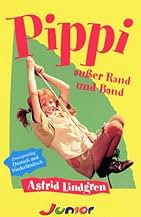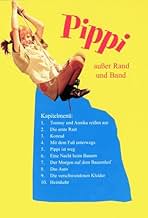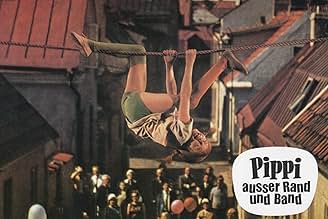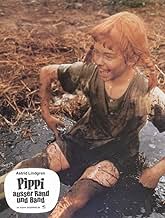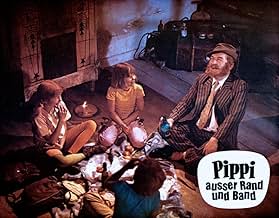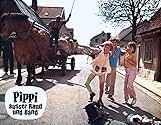NOTE IMDb
6,8/10
4,2 k
MA NOTE
Ajouter une intrigue dans votre langueFed up with their strict parents, Tommy and Annika run away from home, with their friend Pippi Longstocking to look after them in their long trek.Fed up with their strict parents, Tommy and Annika run away from home, with their friend Pippi Longstocking to look after them in their long trek.Fed up with their strict parents, Tommy and Annika run away from home, with their friend Pippi Longstocking to look after them in their long trek.
Histoire
Le saviez-vous
- AnecdotesHans Alfredson (who played Konrad the Peddler in this film) and his "Hasseåtage" comedy troupe partner Tage Danielsson were originally slated to play the policemen Kling and Klang in the Fifi Brindacier (1969) TV series.
- Crédits fousThe original Swedish version opens with Pippi riding astride her horse, Lilla Gubben, against a beautiful sunset, in slow motion. (The film's title is seen here.) A Western-style instrumental arrangement of the film's theme song, "Sommarsången" ("Summer Song"), permeates this scene. There is then a brief scene of Tommy and Annika entering Pippi's home, Villa Villekulla, with Pippi's pet monkey, Mr. Nilsson, in a small bed. Tommy and Annika then attempt to bake bread. Then, the opening credits continue. The same arrangement of "Sommarsången" as before now bursts into full gentle rhythm with soft bongo drums into a montage of Pippi riding Lilla Gubben at full speed in the sunset, some in real-time speed, others in slow-motion. (And occasionally, even two boxed-in shots over black, with some of the credits filling in the black spaces.) The opening credits then conclude with Pippi reaching her destination, Villa Villekulla.
- Versions alternativesThere are two different versions of the opening credits in the US version:
- Just as in the original Swedish version, a shot of Pippi riding Lilla Gubben (her horse) against a beautiful sunset opens the film, accompanied by the sentimental cowboy-style instrumental arrangement of "Sommarsången" ("Summer Song," the film's theme song). We then cut to the scene of Tommy and Annika entering Villa Villekula, looking for Pippi, and only find Mr. Nilsson in bed. Tommy attempts to bake biscuits, while Annika helps him. Just then, the opening credits, over montage shots of Pippi riding on Lilla Gubben against the sunset, begin. In the Swedish version of the credits, the aforementioned arrangement of "Sommarsången" continues, in full rhythm with soft bongo percussions. In the US version, this track is replaced with an instrumental arrangement of the Pippi Longstocking theme song, "Här Kommer Pippi Långstrump" ("Here Comes Pippi Longstocking").
- The other version simply begins with the scene of Tommy and Annika entering Villa Villekula. The original credits are replaced with cute child-like drawings of Pippi Longstocking (the same drawings seen in the US version opening credits of Här kommer Pippi Långstrump (1969)), with the same instrumental arrangement of "Här Kommer Pippi Långstrump" as before.
- ConnexionsFollows Fifi Brindacier (1969)
- Bandes originalesMors Lilla Lathund
("Mother's Little Lazybones")
Composed by Georg Riedel
Lyrics by Astrid Lindgren
Performed by Maria Persson
Commentaire à la une
Truly without any shadow of a doubt a masterpiece of children's cinema. Totally different from US or European cinema: there is no play to the emotions here. It is simply who and what Pippi is: and it is deeply enthralling to children.
We have three children who all LOVE watching these. They are not clever, or brilliantly filmed, have no CGI whatsoever and yet they come back to them again and again and again.
For a child what can be more exciting to have a friend who doesn't need adults, is generous, fun, mischievous, silly, has fantastic adventures, AND is the strongest (yes! strongest!) girl in the world.
This series shaped a generation of Swedes: it is truly is one of the best of all children's cinema. Adults may not get it as much as their children will. Best for those around 3-7 you will be amazed at what they see that we no longer do. Hurrah for Pippi!
We have three children who all LOVE watching these. They are not clever, or brilliantly filmed, have no CGI whatsoever and yet they come back to them again and again and again.
For a child what can be more exciting to have a friend who doesn't need adults, is generous, fun, mischievous, silly, has fantastic adventures, AND is the strongest (yes! strongest!) girl in the world.
This series shaped a generation of Swedes: it is truly is one of the best of all children's cinema. Adults may not get it as much as their children will. Best for those around 3-7 you will be amazed at what they see that we no longer do. Hurrah for Pippi!
- intelearts
- 19 déc. 2006
- Permalien
Meilleurs choix
Connectez-vous pour évaluer et suivre la liste de favoris afin de recevoir des recommandations personnalisées
- How long is Pippi on the Run?Alimenté par Alexa
Détails
- Date de sortie
- Pays d’origine
- Langue
- Aussi connu sous le nom de
- Les randonnées de Fifi Brindacier
- Lieux de tournage
- Sociétés de production
- Voir plus de crédits d'entreprise sur IMDbPro
- Durée1 heure 34 minutes
- Mixage
Contribuer à cette page
Suggérer une modification ou ajouter du contenu manquant

Lacune principale
By what name was På rymmen med Pippi Långstrump (1970) officially released in Canada in English?
Répondre
